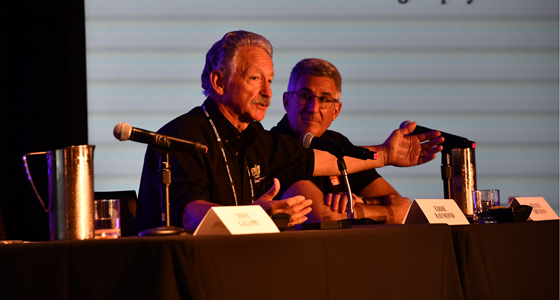Q&A with Eddie Raymond, Immediate Past President of Entertainment Services and Technology Association (ESTA) and safety aficionado…
Why is safety and training is such a passion of yours?
My father suffered from an industrial accident and changed his entire life from then on, which was 40 something years. Building into the entertainment industry, I had been brought up with the idea that you should be able to go home at the end of the day with most of your parts still working, and I wasn’t seeing that.
Being as young and invincible, as we all are when we’re young, I suffered from some of those bad habits myself. You get into this business and the show must go on in spite of whatever of we do.
Looking back, I’m terrified at what I did when I was a young buck in the business. I started to recognize that that was not an appropriate way to behave on the job, and the more involved I got with it, the more passionate I became about trying to recruit people to that point of view because you can’t change your role by yourself.
If you’re going to make a change, you have to get allies, you have to get people who are willing to walk the walk and talk the talk.
Have you seen any changes?
I’ve seen a categorical change in the entertainment world from the 1970s to the 2000s and on. I think one of the things we’re starting to see change, and we’re encouraging through our teachings, is be the person who says, “You know what? You can’t do that. Are you clipped in right now? Where’s your hard hat? Where’s your safety glasses? Do you have reinforced toe shoes on?” Whatever it happens to be. People aren’t afraid to speak up.
Any suggestions for those who see an unsafe practice occurring?
See something, say something, and be part of the solution to whatever the problem is. We had a great incident where someone was doing a load in, and they were being asked to do something that was really dangerous. They actually went on Facebook and asked, “What do you guys think about this?” The people who had taken our classes chimed in and went, “Okay, stop.” There are other ways you can do this work.
Offer those solutions to your employer. Don’t just stop working, walk off, and refuse to do the work. Fix the problem. They did, the show went on, and the employer learned something – that there’s another way to do it that’s safer, even though they’ve been doing it this way for the entire tour.
So, it’s gotten better?
Yeah, it’s gotten better, and it’s about awareness. It really is. It’s been an evolution. I’m still involved with it because I’m still passionate about it. There are people now who are stepping up to take over, and that’s great.
Tell me about your involvement with the New World Rigging Symposium that took place alongside USITT 2018.
It was our inaugural symposium, loosely modeled on a similar thing that they do in London, in conjunction with the PLASA show. We wanted to up the game, of course, so Bill Sapsis and I brought this idea up after USITT 2017 in St. Louis. Bill, Lori Rubinstein (ESTA), and I had been putting it together for the last year.
The idea was to bring in people who were experts in their field, not all of whom were presenters on a regular basis but who have great experiences and stories to tell.
Our keynote speaker was Scott Fisher. Scott doesn’t do a lot of public speaking, but he was totally captivating because he had a story to tell, and people wanted to hear it.
The entire thing was a series of panels of people who were known, who do public speaking all the time, a couple of people who were less known, but very well versed in what they do. It was great, over the top.
What was the response like?
We had a successful turnout. We were nervous. I think we had 162 sign up. There were some weather issues with flying out of the northeast, so we missed a few people, but it was the right sized crowd for what we did.
The right people came. We had a good mix of riggers, venue managers, and people from college, all across the board, who chimed in. The discussion was great. The questions were incredible. That’s what drives these things, the enthusiasm. At the end of it, we asked everybody, “Should we do this again?” It was a resounding yes.
So, will you do it again?
We’ll be doing it again, probably in a year. We’ll see how it goes. Both Bill and I were ecstatic about the turnout, and the participation, and the quality. Everybody brought their A game.
